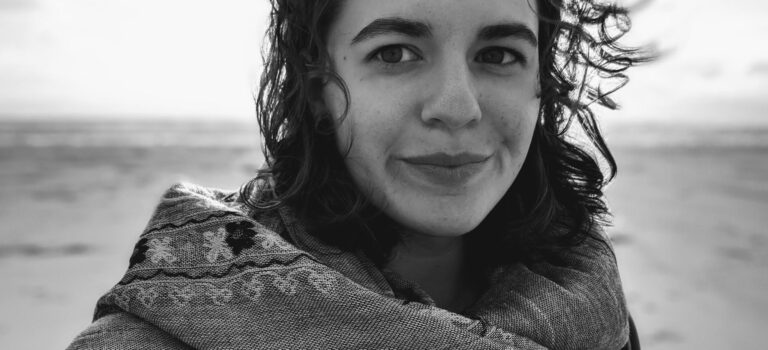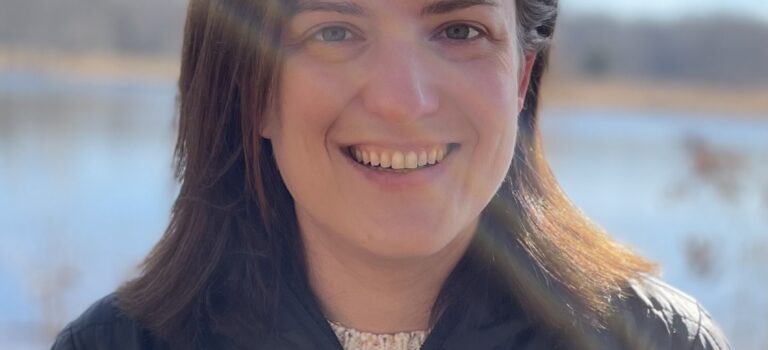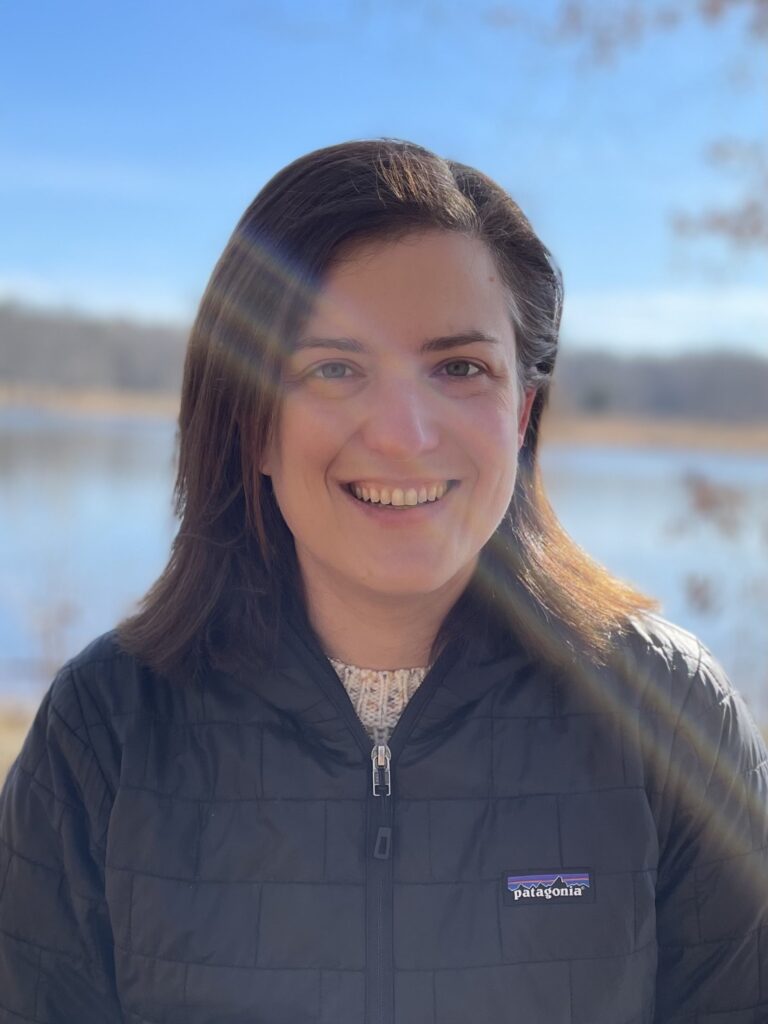First, she found a red drop of blood on her bike seat. It was the day my grandmother convinced herself she was dying, splitting in two at the seams, right down the middle. It was rural Iowa in 1941 and information on growing bodies was hard to come by, harder to discuss. Then, there was a fatal pinprick discovered in her younger sister’s heart. The hole was a gate, and it was just wide enough to take her life. Another flood. My grandma lost her sister the year she got her period. It was the year she found out about all this. All this. The possibility of birth. The guarantee of death.
I can imagine the owl’s eyes glowing on a banister in the family barn, chaperoning late nights for lonesome teenagers. I can hear the two “o’s” in “hoot” as my grandma calls back. I can see her grow up, the way she told me she did: the cereal barrels she cleaned at the Kellogg factory after high school; the nursing hat she wore as a hospital aid; the white lace covering her head before Vatican II; her palms touching in devotion, asking, offering. And I can stay here with her, when
she was most like me now: young, with just a handful of grays (you get one for each person you love, she told me later), not understanding that everything swings around, keeps swinging back, forward, back and forward, hits you in the face sometimes or comes up from behind. At least I think that’s what happens when you turn 30. I’m only 29.
For years, I watched my grandma. Friday nights. Sunday afternoons. Anytime my parents were both working, my sister and I were escorted to her yellow house. And then I got my period. And my parents divorced. And I moved in with her. And I watched her. I watched as she wallpapered every room in the house twice over. As she scrubbed the tiled kitchen floor each week. As she laughed at The Price is Right. As she made bad smelling food and wore too much purple. I saw
everything in her: a childish giggle when we watched cartoons, dentures in a cup when she fell asleep at 4pm. She might ramble an old memory or hum a tune in my ear as I rested in her lap. But never once did I hear her start a sentence with I feel or I love or I want or I at all. I waited. All I wanted was for her to bend down and say I feel sad. I love you. I want to be loved. I need you to understand me. Instead, we orbited. She went through her days. I observed. No one was allowed to be close. To close the distance.
Here’s what happened to her. There was a missed period. There were two wedding rings exchanged, too quickly. There were no birth control pills. There were many rounds of pregnant bellies, many more drops of blood. One child, then another, another, another, another, another, another, another. The sixth baby didn’t survive birth. Another hole in another heart. The seventh baby survived only two days outside the womb. Another fatal pinprick. A gaping hole. A brand of grief, now too familiar. My grandmother’s orbit, predictable encounters with death. The final womb was my own mother. Her entrance into the world was followed by a hysterectomy. The possibility of birth was wrung out.
This next part, I know the least about. I know there were tumblers strewn around the basement by her husband. I know she confessed sins to the priest each week—Bless me, father, but what to confess? I know that one day her second child ran away from home and never came back. I know that on that same day, a hole formed in my grandma’s heart that didn’t kill her but never healed. I know there were conversations that never found their answers—did he call? have you heard
from him? I know that eventually she stopped asking. I know she felt echoes of emptiness inside her. I have looked into her eyes.
The “o” in ok, it’s ok, it’s ok, it’s ok, she said, if you brought up the past. My grandmother was a broken person.
I like to live in the periphery memories. I like to think about the strokes she made on the cat’s back when she listened to Johnny Cash on her record player. I like to think about her purpley lipsticked mouth asking for a divorce at age 62. I like to remember the mouths of the old tumblers repurposed as cookie cutters; her freshly permed curls the day of her weekly hair appointment; the steering wheel of the Oldsmobile turning away after she dropped me off at Catholic school; the cans of tuna she dumped into the noodle casserole; her famous deviled eggs, extra paprika; the decorative ash trays placed around her home; the teacup collection in her living room; the blue oilcloth that covered the kitchen table; the birthday cake I shared with my cousin the year she made us kiss for a photo; the fitted sheet she secured on the spare bed for me after my parents’ divorce; the bowls of instant oatmeal she heated up for me each morning; the way she contorted her lips when she reminded me to “warsh” the kitchen floors; the trashcan where she found the handle of cheap vodka I hid from her in high school; the black opal ring she gave me one day with no explanation; her eyes when she met my first boyfriend—oh my, he is so handsome; her laugh when I broke up with him—you little heartbreaker, just like me; the curls on my head that she wished were her own; the sound of Alex Trebek’s voice in the vents before she fell asleep each night; the way she repeated Birdie, Birdie, Birdie whenever I came down from my room.
I don’t like to think about: the cloth belt that kept her usually robe closed; her large breasts exposed when I found her unconscious on the floor; the search for a heart specialist; the hole in her neck for dialysis treatments; the hand mirror she held while I brushed her unpermed hair; my own reflection in that mirror: wild curls from knotted sleep, cloudy eyes from studied books, slanted teeth from bitten nails. I realized I had missed her my whole life.
I don’t like to think about: the peppermints she said were soothing; our palms touching; the Burger King hamburgers she wanted everyday near the end; her closed eyes.
On her deathbed, she screamed out. She said, I’m tearing in half right down the middle, right down the middle, right down the middle.
The end. Her blood still in mine. My body. Me, making circles around that block where we lived, sometimes in the middle of the night, thinking I understand what it feels like to live with a little hole in your heart. My blood still circulating.
Bridget Lillethorup is a nonfiction writer living in Omaha, Nebraska. She is a lecturer at the University of Nebraska, Lincoln, and an editorial assistant at Literary Mama. More of her writing can be seen in Sweet Lit, Essay Daily, The Rupture, Up the Staircase Quarterly, and others. Learn more about her here.
We are pleased to present an interview with Bridget Lillethorup below, conducted by Taylor Montaño—one of Superstition Review’s nonfiction editors for Issue 30.
Taylor Montaño: As a writer who not only lives in Nebraska, but lectures there as well, how has Nebraskan culture affected your writing?
Bridget Lillethorup: I used to say that if you could find the Nebraska landscape beautiful then you could find anything beautiful. But that’s not to say that anything about this state or the many cultures within it is simple. It just takes a more patient observer to see everything. It takes time, energy, and care to see through Midwestern stereotypes and Nebraska’s whitewashed history. I teach writing to mostly first-year and sophomore students at the University of Nebraska-Lincoln, and we discuss this a lot. We talk about who we are, and how often that directly contrasts with who people think we are. Being from here sometimes feels like an ongoing battle to dismantle perceptions, and this tension comes through in my writing. There’s a lot to wrestle with in being from red state in the Great
Plains. I often consider geography and the communities that raised me as intersections in my work, and I challenge myself to show them as rounded and complicated, just as they are.
TM: Writing can be challenging to some writers as certain aspects can seem mechanic and mundane. One of these challenges is describing yourself or others.
Your craft is interesting in that you describe yourself through comparing/contrasting yourself to others. How do you battle other trials within your writing so that it is original and un-restricting?
BL: I am lucky to be in a writing group with people I trust deeply. For me, writing must always take part in a community. My group has seen my written voice in many forms, some strong examples, and plenty of weak ones too. They help me stay true to myself.
The first drafts of my essays are usually heavy with images and descriptions. Here’s what I saw. Here’s another image it reminds me of. I often struggle to explain to my audience why these images are important to the larger story. My group can see these holes more clearly and quickly than I can. Sometimes it hurts to be vulnerable with this group; they know my weaknesses better than some of my closest friends. But unchecked, I don’t think I could strike the right balance in my writing and would probably write things that would never leave my creaky old desk.
TM: The use of color within Circles is something to take note of. You mention the red blood, the house being yellow, and your grandmother often wearing
purple. How has visual effects such as color allowed you to translate a memory into prose for your reader?
BL: Color is a beautiful tool for translating a memory to the page. Recording images precisely from my imagination has always been important to me. I remember falling in love with books as a kid, and then being so disappointed when I saw the movie version, because the movies didn’t look like what I pictured in my head. (I particularly remember this feeling with The Chronicles of Narnia). I would go home after the movie and try to remember what the characters and places looked like in my imagination before I saw the movie. I was terrified of losing my original renditions.
As a writer, translating the visual aspects of old memories seems similarly urgent. I don’t have access to many spaces of my youth anymore. My grandma’s house was renovated and has sold twice since I lived there. I want to remember everything exactly the way it was. It’s a fool’s errand, but an important one. I remember the color of the tiles in the bathroom, but not what she kept behind the mirrors. Why? I was never invited “behind the scenes” of her makeup routine. That’s interesting to me. What I remember, or don’t remember, leads me to meaning, which I can then explore through prose.
TM: Furthermore, how—do you think—does utilizing color allow doors to open within your writing?
BL: I clearly remember my art teacher in third grade giving a lesson on the color red. She told us that red is the first color that the human eye detects. Humans are naturally drawn to its deep hues, she said. The assignment that day was to draw a wintery scene that was blue and white save for one element, which had to be red. It could be the scarf on a snowman, a roof, a shovel, etc. It was our choice—where did you want our audience’s eyes to be drawn? What did we want them to remember?
I don’t know if that factoid about the color red is all truth, and obviously people’s perceptions of color vary vastly. But I like the sentiment behind her lesson: when used sparingly, adding color can highlight even the smallest details, or make our big sentiments bolder. Although, saturating an essay with color sounds fun, too.
TM: Your piece has a voice that is uniquely yours. You have parts in which you are honest with your reader and mention in a matter-of-fact tone that “this is what [you] know.” What are the advantages and disadvantages of your perspective alone?
BL: I think it’s important to acknowledge the limitations of your own perspective in writing. I am reminded of something the late Brian Doyle wrote in his famous essay, “Joyas Voladoras ”: “We are utterly open with no one in the end—not mother and father, not wife or husband, not lover, not child, not friend.” I agree; you can never really know someone. I don’t ever want to write an essay where I argue that I have the whole story of someone’s life. I can only present what I see and tell you what I think of it.
For this particular essay, I could have interviewed other people in my grandma’s life to get more angles on my own interpretation of her. I’m sure that would have been a rich experience and given me different ideas to think about. The way a person remembers an event or person is deeply individual. I remember color and shapes, but my sister might remember conversations and verbal expressions better than me, while my mother might remember feelings above all else. For this essay, I was particularly drawn to the lines of connection I felt between my grandma and me. I wanted to keep it tight and focus on what a young person can learn from a grandparent, despite age differences and communication barriers.
TM: You take the concept of circles—circling her house symbolizing your blood cycling within you—and use it to clearly tell your story. Do you often find
semblances through shapes to tell your stories? If not, how does utilizing this shape within “Circles” help your reader glimpse into what you have experienced?
BL: At some point in the drafting process, I have to visualize a structure in order to move forward. Maybe it’s a braid, a series of folds, or a circle, like in this essay. I think shapes carry meaning and associations just like any other literary element. I was drawn to the circle for this essay because it represents processes: fertility, birth, death, grief, blood circulation. When I think of my grandma, I feel these circles moving around me.
I’ve never forgotten the story my grandma told me of getting her period as an adolescent and being terrified that she was dying. As a young girl myself, I related to that fear a lot, and that was one of the first moments I felt a kindship between our lived experiences. I don’t think my grandma and I had too much in common, but we are related, and her experiences live in me somewhere, even the ones I’ll never know about. Her life still circulates in me, and I feel that deeply.



